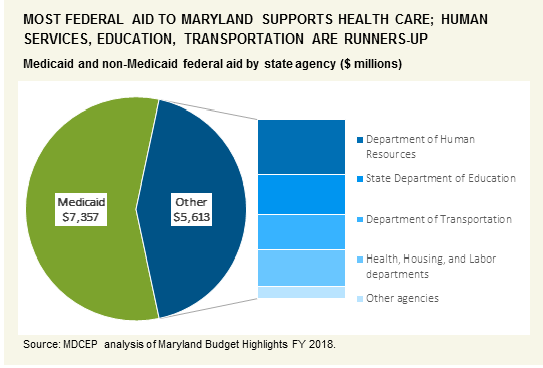Federal Aid Supports Essential State and Local Investments in Maryland
As weak revenues continue to make it challenging for Maryland’s state and local governments to provide the services we all rely on, policy developments in Washington threaten to make things much worse. Federal assistance provides essential support to the public investments that make Maryland’s economy strong, accounting for 30 percent of the state budget and 18 percent of combined state and local revenues.[i] This money supports Maryland schools and universities, keeps our highways and railroads in good condition, and ensures that struggling Marylanders can get medical care when they need it. Deep cuts in the Trump administration’s budget and the Affordable Care Act repeal bill passed by the House of Representatives would drastically reduce this support, making it harder for the state to continue needed investments and weakening our economy.
Federal Aid Is Essential to the State Budget
The governor’s spending proposal for the next fiscal year counts on $13 billion in federal aid, amounting to 30 percent of the state budget.[ii] Federal revenue is spread across nearly every major state agency, and in several agencies provides the majority of funding.
The single largest source of federal aid to the state is Medicaid, which provides needed medical care to 1.3 million Marylanders[iii] – families struggling to make ends meet, adults and children with disabilities, and people whose jobs don’t pay enough to maintain a decent standard of living. Maryland receives $7.4 billion in federal funding through Medicaid, accounting for 57 percent of federal aid and 17 percent of the state budget overall. The Department of Health and Mental Hygiene administers about 98 percent of federal Medicaid funds in the state budget.

Six state agencies receive most of the remaining $5.6 billion in federal aid:
- Department of Human Resources ($1.7 billion): This money goes primarily toward nutrition, child wellbeing, and poverty reduction. The largest component is $1.1 billion from the Supplemental Nutritional Assistance Program (SNAP, formerly food stamps), which provides modest benefits to help families put food on the table. SNAP benefits 679,000 Marylanders, including one in five of the state’s children, and has been shown to lead to better child health and a better chance of finishing high school.[iv] The remainder goes toward foster care, child support enforcement, workforce development, home energy assistance, and several other activities. Five percent of the federal revenue in the Department of Human Resources goes toward cash assistance to families. Federal aid accounts for two-thirds of the department’s funding.
- State Department of Education ($1.3 billion): The majority of this money is passed through to local school districts. It includes $232 million in aid to low-income districts (Title I), $210 million in special education grants, and $340 million in school meals funding to ensure that all students go to class well fed and ready to learn. The State Department of Education also receives funding for child care assistance and workforce development services for youth and adults with disabilities.department of transportation ($1.1 billion): This includes $637 million for highway construction and maintenance as well as $397 million for transit maintenance.
- Department of Health and Mental Hygiene ($661 million): In addition to Medicaid funding, the Department of Health and Mental Hygiene receives $319 million from the Children’s Health Insurance Program, which provides insurance to children in struggling families that are not eligible for Medicaid. Another $113 million from the Supplemental Nutrition Program for Women, Infants, and Children (WIC) ensures that children and pregnant women in low-income families have the nutrition they need for healthy development.
- department of housing and community development ($296 million): This money primarily goes toward Section 8 Housing Assistance, enabling families to obtain decent housing at an affordable price. Federal housing assistance benefits 186,000 Marylanders.[i] Federal aid accounts for two-thirds of this agency’s funding.
- department of labor, licensing, and regulation ($179 million): This includes $92 million for unemployment insurance benefits and administration, with most of the remainder going toward workforce development and adult education.
Federal funding for environmental activities is spread across multiple state agencies and totals $121 million, or 12 percent of the state’s environmental spending. This includes $54 million from the federal government for restoration of the Chesapeake Bay.
 Read more about how federal budget cuts would harm Maryland.
Read more about how federal budget cuts would harm Maryland.
[i] Analysis of Department of Housing and Urban Development data by the Center on Budget and Policy Priorities.
[i] “Maryland Budget Highlights: FY 2018,” Department of Budget and Management, 2017, http://dbm.maryland.gov/budget/Documents/operbudget/2018/FY2018Highlights.pdf.
“State and Local Government Finances by Level of Government and by State: 2014,” U.S. Census Bureau, 2017, https://factfinder.census.gov/bkmk/table/1.0/en/SLF/2014/00A1/0400000US24.
[ii] “Maryland Budget Highlights.”
[iii] “Medicaid and CHIP in Maryland,” Centers for Medicare and Medicaid Services, 2017, https://www.medicaid.gov/medicaid/by-state/stateprofile.html?state=maryland.
[iv] “Supplemental Nutrition Assistance Program: Number of Persons Participating,” U.S. Department of Agriculture, 2017, https://www.fns.usda.gov/sites/default/files/pd/29SNAPcurrPP.pdf.
Steven Carlson, Dottie Rosenbaum, Brynne Keith-Jennings, and Catlin Nchako, “SNAP Works for America’s Children,” Center on Budget and Policy Priorities, 2016, http://www.cbpp.org/research/food-assistance/snap-works-for-americas-children.
